Module 5 - OCR A Level Biology
1/279
There's no tags or description
Looks like no tags are added yet.
Name | Mastery | Learn | Test | Matching | Spaced |
|---|
No study sessions yet.
280 Terms
5.1.1 COMMUNICATION AND HOMEOSTASIS
5.1.1 COMMUNICATION AND HOMEOSTASIS
why do multicellular organisms need communication systems?
e.g hormonal, nervous
So they can respond to changes in the internal and external environment + coordinate the activities of different organs.
responses can be behavioural or physiological
How does responding to the environment help organisms survive?
increase chance of survival by responding to changes in external enviro. e.g by avoiding harmful enviro. (too hot/cold)
respond to changes in internal enviro. to make sure conditions are optimal for their metabolism
what factors do cells need to keep constant
conc. of chemicals e.g glucose and sodium
pH
water potential
temperature
low levels of toxins e.g urea
levels of gases
so enzyme-controlled reactions can take place
Important that CO[2] does not build up as it reacts with water to form carbonic acid which releases H+ ions which lowers pH --> enzymes
why is it so important to maintain core body temperature at around 37 °C ?
what happens at too high and too low temps?
temp affects enzyme activity and enzymes control the rate of metabolic reactions
when temp too high enzymes tertiary structure breaks, active site changed, denatured.
when temp is too low, enzyme activity reduced, slows rate of metabolic reactions.
Which molecules are used to transport signals over long distances between cells?
How are they recognised?
Hormones which are transported in the blood
target cells have cell surface receptors allow cells to recognise the hormones
Which type of hormone is lipid soluble- steroid or non-steroid?
Steroid
Which property of non-steroid hormones stops them passing through the cell membrane?
Hydrophilic
If a response is slow, which messenger system most likely transmitted it? Hormonal or nervous?
Hormonal
If a response is short-lived which messenger system most likely transmitted it? Hormonal or nervous?
Nervous
If a response has a permanent and irreversible effect, which messenger system most likely transmitted it? Hormonal or nervous?
Hormonal
difference between hormonal and neuronal communication?
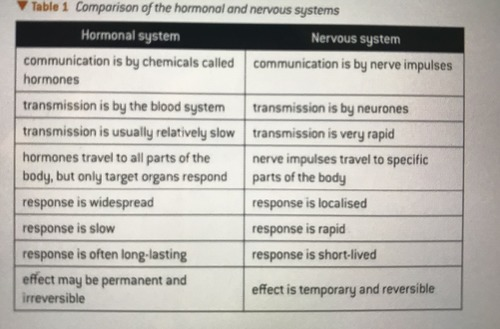
What is homeostasis?
is the maintaining of a constant internal environment in a constant or steady state despite any changes in the external environment
**constant meaning that conditions will vary within acceptable range to not change body functions
What is negative feedback?
A mechanism that counteracts changes (in internal conditions when the changes cause the a shift away from the normal)
Ensures optimum internal conditions are maintained.
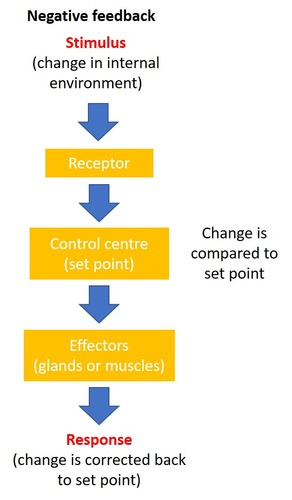
A homeostasis diagram showing the template for an exam question
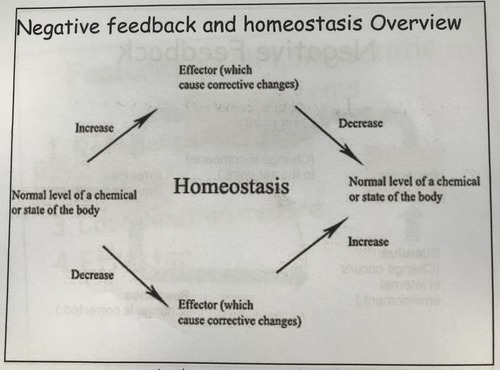
graph diagram of negative feedback
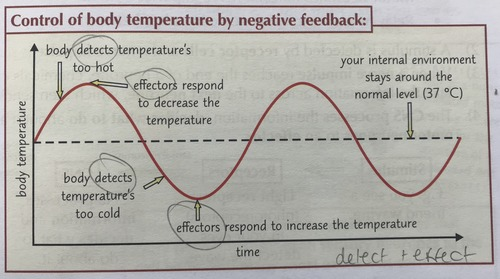
what is positive feedback?
the process in that effectors increase (magnify) any change detected by the receptors.
not used in homeostasis bc doesn't keep environment constant
give some examples of processes which use positive feedback
Blood clot: platelets become activated and release chemical → more platelets triggered → blood clot formed → ends in negative feedback when body detects formed blood clot
control of ovulation: follicles stimulate oestrogen production → stimulates more follicle cells to develop → process ends in negative feedback when LSH stops maturation
Breast feeding: suckling stimulates nerve endings in nipple → stimuli carried to hypothalamus → hypothalamus produces oxytocin → oxytocin stimulates milk production
if suckling stimulus not strong, not as much oxytocin produced, not as much milk produced
Birth: head of baby presses against cervix → stimulates production of oxytocin → oxytocin stimulates uterus to contract → pushes babies head harder against cervix → triggers more oxytocin
What are changes in the internal and external environments known as?
Stimuli
What is the term for an organism that does not control their body temperature internally?
Ectotherm
their body temp fluctuates with the environment, they can't increase respiration rate to generate heat e.g reptiles, fish
What is the term for an organism that can control its body temperature internally?
Endotherm
can genrate heat via exergonic reactions
why do many ectotherms living in water not need to thermoregulate?
why is living on land problematic for an ectotherm?
water has high heat capacity means the temp of their enviro. does not change much.
temp of air can vary a lot e.g diff. seasons
How do ectotherms control their body temperatures?
Changing behaviour
what are some behavioural responses of ectotherms to increase/reduce the radiation they absorb from the sun?
to warm up:
bask in sun
orientate body so max surface area is exposed to the sun
conduction → press body against warm ground
exothermic metabolic reactions
to cool down:
shelter from sun
press body against something cool
orientate so min surface area exposed
minimise movements to reduce metabolic heat generated
Advantages and disadvantages of ectotherms
Advantages
Less food used for respiration hence they need to find less food
A greater proportion of their energy can be used on growth
Disadvantages
Less active in cooler temperatures hence at great risk of predation and also need to the day of by basking in the sun.
Aren't capable of activity during winter hence need large food stores.
Advantages and disadvantages of endotherms
Advantages
a constant temperature regardless of the environment
active even in times of low temperatures
ability to inhabit colder environments
Disadvantages
significant amount of energy used to maintain body temperature
more food required (need to spend a lot of time eating)
less energy used for growth
what are some physiological responses of ectotherms to warming?
dark colours in colder climates to absorb more heat radiation
some ectotherms can alter heart rate to increase or decrease metabolic rate
what do peripheral temperature receptors do and why?
We have receptors in our skin which detect surface temperature before it can affect the core body temperature by sending nerve impulses to the thermoregulartory centre of the hypothalamus.
what are some behavioural responses of endotherms to increase/decrease their temperature?
list extras for humans
warm up:
bask in sun
conduction
hibernation
cool down:
wallowing in water + mud
digging burrows = both
Humans
clothes worn to stay warm
houses heated
How does shivering increase body heat?
More heat is produced from increased respiration
How do adrenaline and thyroxine increase body heat?
Increase metabolism
How does sweating reduce body temperature?
When sweat evaporates it takes heat from the body
How is the temperature of the blood detected?
As the blood flows past the thermoregulatory centre (TRC) of the hypothalamus, the TRC then detects whether the temp. of the blood is above or below normal. If so it carries out a response by negative feedback to get the blood back to normal.
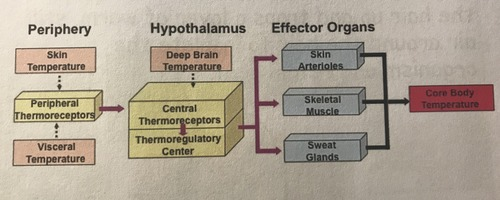
Temperature rise is detected by ...
... thermoreceptors in the thermoregulatory centre in the hypothalamus and peripheral receptors in the skin
Do a negative feedback loop for temperature rising and decreasing
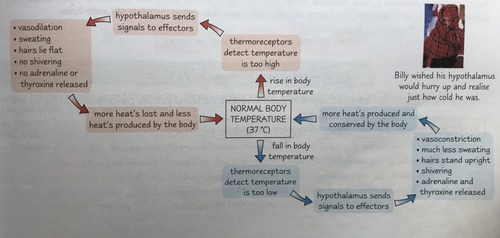
what are physiological adaptations of endotherms to cool down? (to maintain stable body temp)
vasodilation
increased sweating: sweat glands all over body, as sweat evaporates from the surface of the skin, heat is lost, cooling the blood
reducing insulating effect of hairs/feathers: Hairs/feathers are flat. Less air trapped hence less insulation
panting: Panting increases, losing heat as water evaporates bc some animals can't sweat
Liver cells: Rate of metabolism is reduced hence less exogenic reactions occur
what are physiological adaptations of endotherms to warm up? (to maintain stable body temp)
vasoconstriction
decreased sweating some evaporation from lungs may still occur but overall water stops evaporating
raising body hair/feathers: Hairs are raised hence trap air hence increased insulation
shivering: spontaneous involuntary contractions which generate metabolic heat by causing muscle cells to respire
Liver cells: Rate of metabolism increased hence more exogenic reactions occur
Hormones: adrenaline and thyroxine released which increase metabolism → more heat
explain vasocontriction and vasodilation in detail
vasodilation: arterioles near surface of the skin dilate which forces blood through the capillary networks close to the surface of the skin. Heat lost by convection and radiation.
vasoconstriction: arterioles near surface of the skin constrict so little blood flows through the capillary networks close to skin, warm blood is kept below the surface. Sphincters muscles also tighten and restrict bloods access to capillaries near surface of skin (yellow in diagram). little radiation takes place.
(diagram correctly shows the capillaries do not expand as their walls are one cell thick, no elastic fibres/muscle to stretch or recoil)
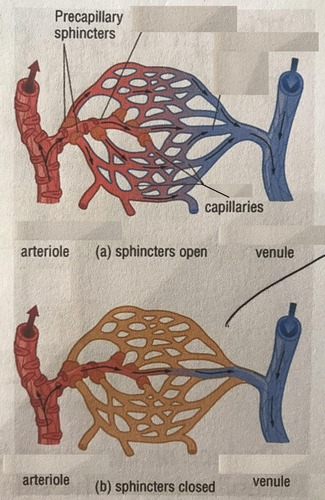
What are adaptions of endotherms living in cold climates?
minimise SA:V ratio e.g small ears
thick layer insulating fat + fur
hibernate (lower metabolic rate)
5.1.1 COMMUNICATION AND HOMEOSTASIS
5.1.1 COMMUNICATION AND HOMEOSTASIS
5.1.2 EXCRETION AS AN EXAMPLE OF HOMEOSTATIC CONTROL
5.1.2 EXCRETION AS AN EXAMPLE OF HOMEOSTATIC CONTROL
What is urea formed from?
Ammonia and carbon dioxide
Which blood vessel supplies oxygenated blood to the liver?
Hepatic artery
Which blood vessel takes deoxygenated blood away from the liver?
Hepatic vein
Which blood vessel brings blood from the small intestine to the liver?
Hepatic portal vein
Why is bile produced?
To emulsify fats
What type of cells are liver lobules made up of?
Hepatocytes
What is the name for the capillaries in the liver that connect the central vein to the hepatic artery and hepatic portal vein?
Sinusoids
What is the name for the cells on the walls of the sinusoids that remove bacteria and break down old red blood cells?
Kupffer cells
What connects the bile duct to the central vein?
Canaliculi
Where in the kidneys does ultra-filtration take place?
Glomerulus
What are the three layers that the liquid and small molecules pass through from the glomerulus to the Bowman's capsule?
Capillary wall, basement membrane and epithelium
Where does selective reabsorption in the kidneys take place?
PCT, loop of Henle and DCT
Where are ions actively pumped out of the nephron?
Near the top of the ascending limb
Where does water move out of the nephron?
Descending limb and collecting duct
Where do ions diffuse out of the nephron?
Near the bottom of the ascending limb
How is water potential monitored?
Osmoreceptors in the hypothalamus
How does ADH affect water levels in the blood?
Increases
What is measured to detect kidney failure?
Glomerular filtration rate
What can kidney infections cause?
Inflammation of the kidneys
How can high blood pressure damage the kidneys?
Damage the glomeruli
What can be caused by long term kidney failure?
Anaemia
Which hormone do pregnancy tests detect?
hCG
5.1.2 EXCRETION AS AN EXAMPLE OF HOMEOSTATIC CONTROL
5.1.2 EXCRETION AS AN EXAMPLE OF HOMEOSTATIC CONTROL
5.1.3 NEURONAL COMMUNICATION
5.1.3 NEURONAL COMMUNICATION
Where does the sensory neurone transmit nerve impulses from?
Receptors
Which type of receptor is a Pacinian corpuscle?
Mechanoreceptor
What is a transducer?
Something that converts one form of energy to another
Where are Pacinian corpuscles found?
Skin
In the formation of a neurone's resting potential, how many sodium ions are pumped out for every two potassium ions pumped in?
3
Neurone diagrams
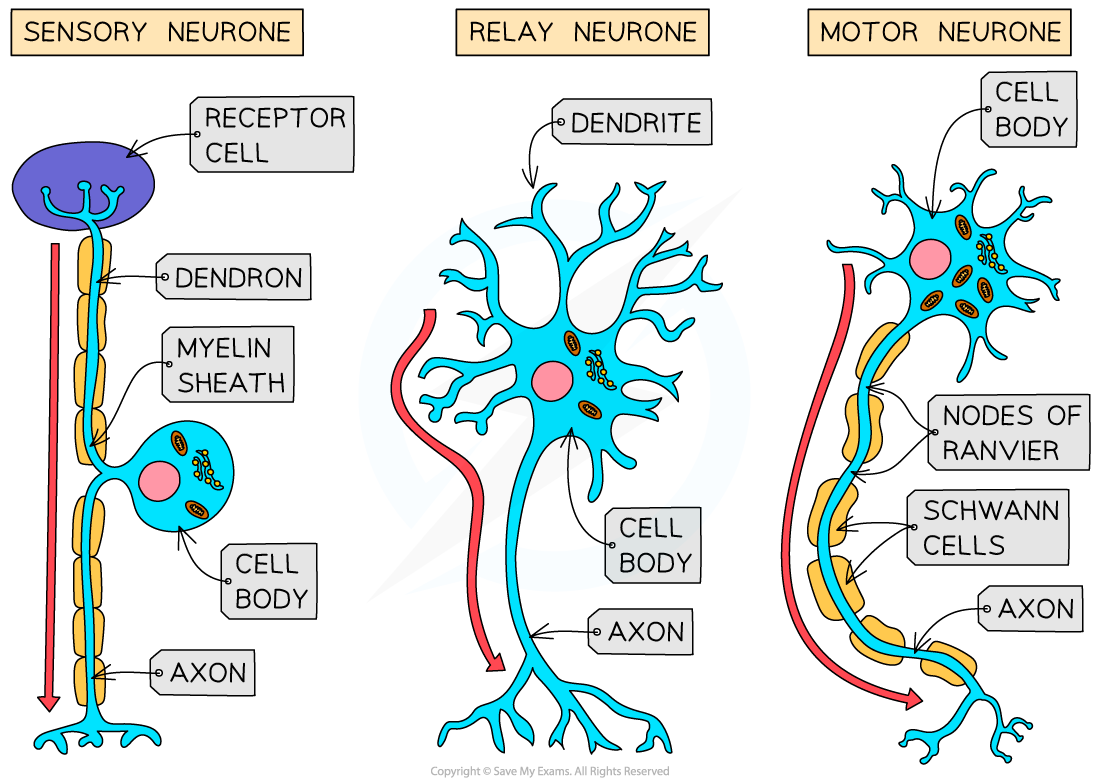
What is the resting potential of a neurone?
-70mV
What is the threshold for depolarisation?
-55mV
At which potential difference does repolarisation occur?
+30mV
What is the term for spaces between myelin sheaths on a neurone?
Nodes of Ranvier
Why does hyperpolarisation of the neurone occur?
Potassium ion channels are slow to close
Which cells make up the myelin sheath?
Schwann cells
In which type of neurone does saltatory conduction occur?
Myelinated neurone
Which ions cause the neurotransmitter to be released from the synaptic knob?
Calcium ions
Where do dendrons send electrical impulses?
Towards the cell body
Where do axons send electrical impulses?
Away from the cell body
Why does a larger axon diameter increase the speed of the transmitted impulse?
Less resistance
What is a synapse?
Junction between two neurones
What is the term for the gap between the axon of one neurone and the dendron of another?
Synaptic cleft
What do synaptic vesicles contain?
Neurotransmitters
Where in the body are cholinergic synapses found?
CNS and neuromuscular junctions
What is the term for when signals from multiple stimuli are coordinated into a single response?
Spatial summation
What is the term for when two or more nerve impulses arrive in quick succession from the same pre-synaptic neurone?
Temporal summation
5.1.3 NEURONAL COMMUNICATION
5.1.3 NEURONAL COMMUNICATION
5.1.4 HORMONAL COMMUNICATION
5.1.4 HORMONAL COMMUNICATION
what is an exocrine gland?
give examples
secretes substances via a duct e.g into organs or surface of skin and not into the blood stream
e.g saliva gland, pancreas
what are hormones?
how do they work?
Chemical messengers that travel in the blood to target cells/tissues.
They can be proteins e.g insulin or steroids e.g progesterone
Hormones secreted into blood, each hormone only binds to specific receptors for that hormone found on membrane of some cells (target cells). Diffuse out of blood to bind with target cells which produce a response.
what can glands be stimulated by?
a change in the conc of a specific substance
electrical impulses
another hormone
list the major endocrine glands and the hormones they secrete
Pituitary:
growth hormone
anti-diruetic hormone
LH + FSH
Thyroid:
thyroxine → controls rate of metabolism
Adrenal:
adrenaline → increases heart + breathing rate + raises blood sugar level
cortisol
Testes:
testosterone → sperm production
Thymus:
thymosin → maturation of white blood cells
Pancreas:
insulin
glucagon
Ovaries:
oestrogen → ovulation
progesterone → embryo receiving lining prep
label the endocrine glands
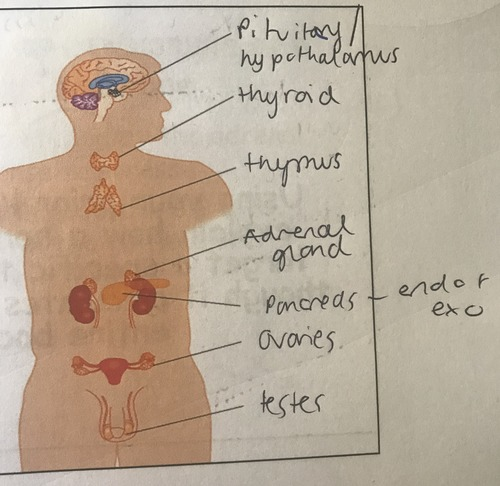
describe the structure of an adrenal gland?
where are the adrenal glands located?
adrenal cortex: the outer region of the glands which produces essential hormones such as cortisol + aldosterone
adrenal medulla: inner region, produces non-essential hormones such as adrenaline
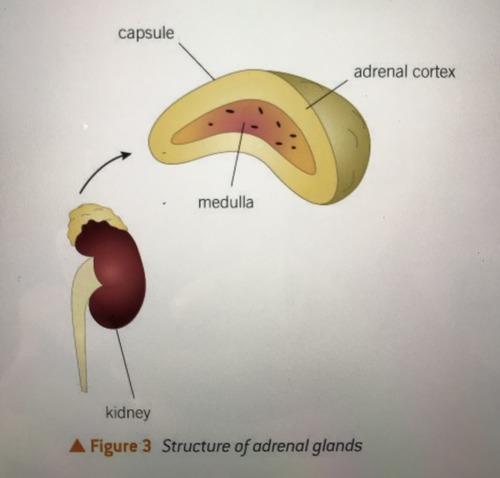
What hormones does the adrenal cortex secrete and what roles do they have?
what type of hormones are these?
cortisol:
regulates metabolism by controlling how many biological molecules e.g fat are converted into energy.
regulate blood pressure
regulate immune response + suppress inflammation
release controlled by hypothalamus
Aldosterone:
controls blood pressure by maintaining balance of water + salt concs in blood + bodily fluids
release triggered by kidney
also secretes androgens
they are steroid hormones
what effect does stress have on the adrenal cortex?
in response to stress it releases cortisol + aldosterone:
stimulates breakdown of proteins and fats into glucose which increases amount of energy available so brain + muscles can respond to situation
increases blood volume and pressure by increasing uptake of sodium ions + water by kidneys
suppresses the immune system
also secretes androgens
what is an endocrine gland?
give examples
group of specialised cells that secrete hormones directly into the blood stream
e.g pancreas + adrenal glands
What are the three main types of hormone produced by the adrenal cortex?
Glucocorticoids, mineralcorticoids and androgens